-
-
 Energy and Climate Databases
Energy and Climate Databases- The most comprehensive and up-to-date annual energy database.
- Monitoring of technology providers in H2 supply chain.
- Monthly energy data on key energy markets.
- The most reliable and up-to-date power generation database.
- The essentials of LNG trade at your fingertips.
- Global monitoring of new and existing refineries.
- Analyse energy consumption and efficiency trends at world level. Benchmark countries.
- Have your database developed by a recognised expert of both energy and IT.
-
 Energy - Climate Forecasts
Energy - Climate Forecasts- Instant access to energy and emissions forecasts.
- Strategic, annual wholesale price projections backed by Enerdata's energy modelling expertise and our globally recognised POLES model.
- Wedges module showing a breakdown of the levers enabling to reduce emissions between two scenarios.
- Unique, independent projections of consumption by end-use.
- GHG Marginal Abatement Cost Curves.
- Benefit from proven models to draw your own energy scenarios and anticipate tomorrow’s challenges.
-
 Market Intelligence
Market Intelligence- 110 Energy and climate country reports
- A newsletter to receive the latest updates on evolving technologies and policies.
- Global energy news and analyses curated daily.
- Enerdata’s experts bring you the essentials about your market and competitors.
-
-
-
 Market Analysis
Market Analysis- Understanding key consumption trends and drivers across sectors.
- Granular and exclusive insight to address the most pressing business and strategic issues.
- Expertise in strategic and business intelligence, with fine-tuning to the market’s specificities.
-
 Energy - Climate Scenarios
Energy - Climate Scenarios- Providing the outlook of an energy commodity in mid to long term time horizons.
- Sector and driver specific energy demand forecasting.
- Assess the evolution of energy prices on the international and regional markets, as well as end-users prices.
- Enerdata guides you through pathways to reach climate targets.
- Supporting local authorities in their decarbonisation strategies.
-
 Climate Strategy and Policy Evaluation
Climate Strategy and Policy Evaluation- Cutting-edge quantitative tools and relevant indicators to monitor and evaluate evolutions on worldwide energy markets.
- Analysis of the most cost-effective options to reduce emissions.
- Quantified simulation and analysis of pledges for climate change negotiations.
- Breakdown of carbon markets and evaluation of the climate change impacts on the carbon price.
- Enerdata guides you on the most beneficial policy or investment options.
- Turning climate objectives into concrete action plans.
-
 Training
Training- Understand different policy targets and measures on energy efficiency.
- How to measure energy savings?
- Energy Forecasting is a 2 days training to learn to design and interpret energy forecasts.
- Energy statistics training allowing to create energy balance with supply, transformation and consumption and understanding the international energy statistics regulations.
- Initiation to EnerMED level 1is the training to approach on the most powerful energy demand forecasting model.
-
-
Resource Centre
Iran Key Figures
- Population:
- 88.6 million
- GDP growth rate:
- 2.51 %/year
- Energy independence:
- 100%
Data of the last year available: 2022
- Total consumption/GDP:*
- 111 (2005=100)
- CO2 Emissions:
- 7.16 tCO2/capita
- Rate of T&D power losses:
- 11.1%
* at purchasing power parity
View all macro and energy indicators in the Iran energy report
Iran Energy News
View all news, archive your new and create your own daily newsletters only on your topics/countries of interest with Key Energy Intelligence
Iran Energy Research
Benefit from up to 2 000 up-to-date data series for 186 countries in Global Energy & CO2 data
A data overview is available in the global energy statistics app
Iran Total Energy Consumption
Per capita energy consumption stands at 3.2 toe (similar to that in the Middle East or the EU average), including about 3 400 kWh in 2022.
Energy consumption has stabilised since 2018 and stood at 276 Mtoe in 2022. It grew by +3.7%/year between 2010 and 2018.
Natural gas accounts for about 70% of total energy consumption since 2016 and its share has been steadily progressing (+10 points since 2010). The share of oil in total consumption has decreased by almost 10 points since 2010, reaching 30% in 2022. Primary electricity (mainly hydro) is marginal (1%).
Interactive Chart Iran Total Energy Consumption
Benefit from up to 2 000 up-to-date data series for 186 countries in Global Energy & CO2 data
View the detailed fondamentals of the market at country level (graphs, tables, analysis) in the Iran energy report
Iran Crude Oil Production
Oil production has increased rapidly since 2020, reaching 157 Mt (+18% in 2021 and +6% in 2022), after a significant decrease over 2017- 2020 (-17%/year) because of renewed international sanctions and COVID in 2020. Previously, it had dropped by 4.6%/year between 2010 and 2015 to 161 Mt, because of international sanctions. It increased by 33% in 2016 after the lifting of those sanctions and reached a peak at 221 Mt in 2017, above its 2003-2010 average (around 215 Mt).
Interactive Chart Iran Crude Oil Production
Benefit from up to 2 000 up-to-date data series for 186 countries in Global Energy & CO2 data
Additionally, for more detailed information on refineries, you can request a sample of our EMEA Refineries Dataset
Iran Oil Products Consumption
Oil consumption recovered its pre-COVID-19 volumes of 76 Mt in 2022, after a 9% decrease due to price adjustments and COVID-19 restrictions in 2020.
Transport is the main consuming sector, reaching 51% of the total, well ahead of industry (25% including non-energy uses), buildings (9%), and the power sector (11%).
Graph: OIL CONSUMPTION (Mt)
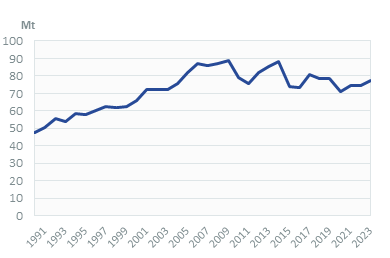
Graph: OIL CONSUMPTION BREAKDOWN BY SECTOR (2022, %)
Interactive Chart Iran Refined Oil Products Production
Benefit from up to 2 000 up-to-date data series for 186 countries in Global Energy & CO2 data
Additionally, for more detailed information on refineries, you can request a sample of our EMEA Refineries Dataset
Iran Natural Gas Consumption
Gas consumption grew by 1.4%/year between 2017 and 2022, reaching 221 bcm in 2022. Previously, it had jumped by 8%/year between 2013 and 2017.
The power sector is the largest gas consumer with 32% in 2022, closely followed by buildings (28%) and industry (27%). The share of buildings is declining (33% in 2010), while the share of industry is stable.
Graph: NATURAL GAS CONSUMPTION (bcm)
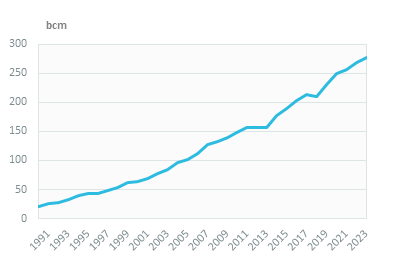
Graph: GAS CONSUMPTION BREAKDOWN BY SECTOR (2022, %)
Interactive Chart Iran Natural Gas Domestic Consumption
Benefit from up to 2 000 up-to-date data series for 186 countries in Global Energy & CO2 data
Additionally, for more detailed information on the LNG trade, you can request a sample of our EMEA LNG Trade Dataset
Iran Coal Consumption
Coal consumption is low and has been quite stable since 2018 (about 2.5 Mt on average). Most consumption is concentrated in industry (>70%).
Graph: COAL CONSUMPTION (Mt)
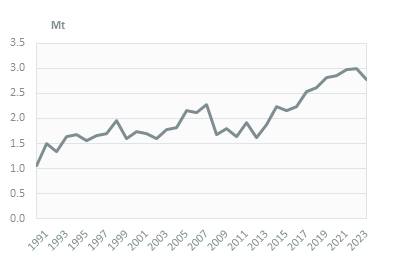
Graph: COAL CONSUMPTION BREAKDOWN BY SECTOR (2022, %)
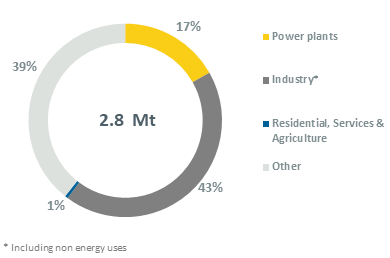
Interactive Chart Iran Coal and Lignite Domestic Consumption
Benefit from up to 2 000 up-to-date data series for 186 countries in Global Energy & CO2 data
View the detailed consumption trends at country level (graphs, tables, analysis) in the Iran energy report
Iran Power Consumption
Electricity consumption has been increasing by 4%/year since 2010, reaching 292 TWh in 2022. Most of the population is electrified (99.5%).
The residential sector represents 33% of electricity consumption, followed by industry (33%) and services (18%). The remainder (16%) is consumed in the oil and gas sector.
Graph: ELECTRICITY CONSUMPTION (TWh)
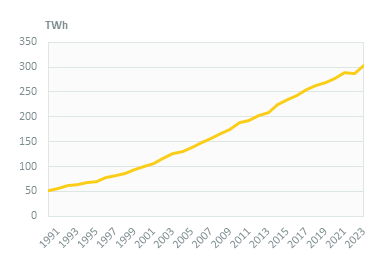
Graph: ELECTRICITY CONSUMPTION BREAKDOWN BY SECTOR (2022, %)
Iran Renewable in % Electricity Production
Before its integration into SATBA, SUNA (Iran Renewable Energy Organization)was the regulatory authority overseeing renewable policy development and renewable project licensing and securing power purchase agreements (PPAs) with renewable power producers.
In the 6th Plan, the country aimed at reaching 4.5 GW of wind and 0.5 GW of solar capacities by 2021, with an additional 2.5 GW by 2030. The 2021 targets were missed by far, as only 350 MW of wind and 540 MW of solar are currently in operation.
Interactive Chart Iran Share of Renewables in Electricity Production (incl hydro)
Benefit from up to 2 000 up-to-date data series for 186 countries in Global Energy & CO2 data
Iran CO2 Fuel Combustion/CO2 Emissions
Because of the economic sanctions, Iran has not ratified the Paris Agreement and has not submitted its NDC. In its INDC (2015), Iran committed to reducing its GHG emissions by 4% (unconditional pledge) and up to 12% (conditional on international financial and technical assistance) by 2030 compared to a BAU scenario.